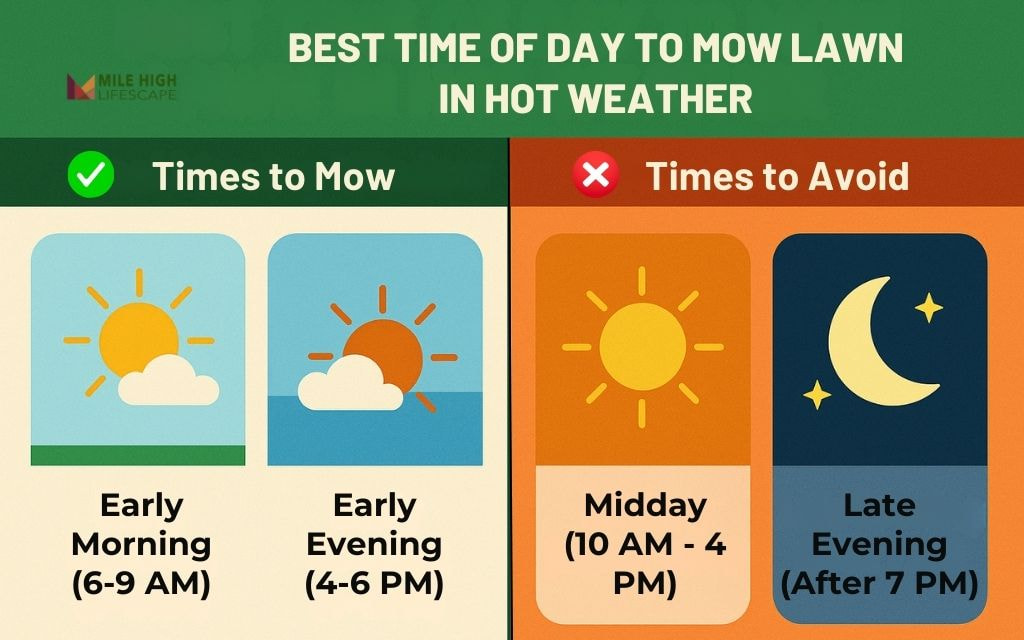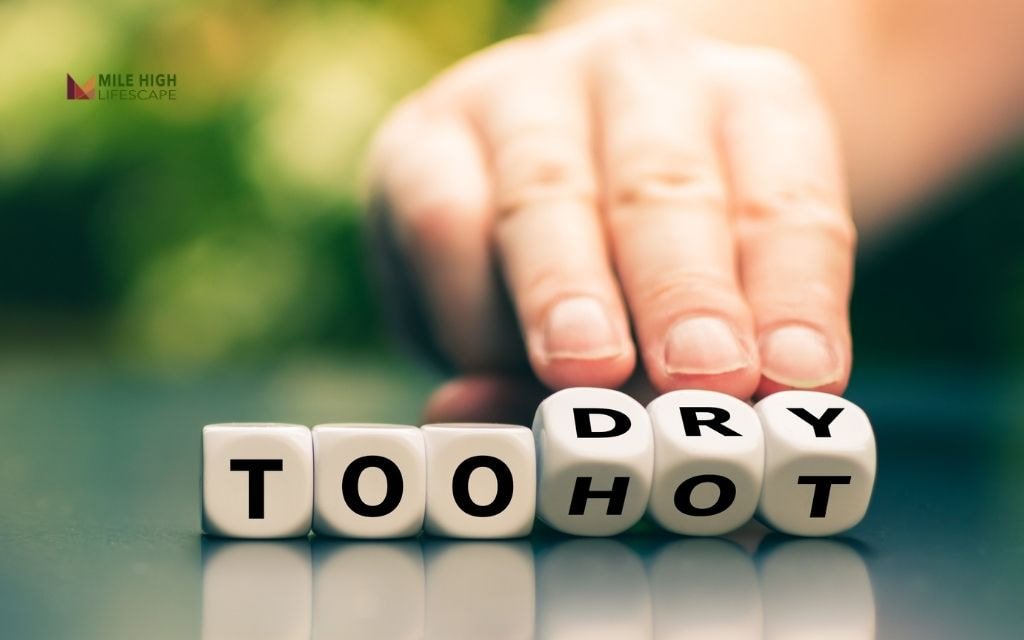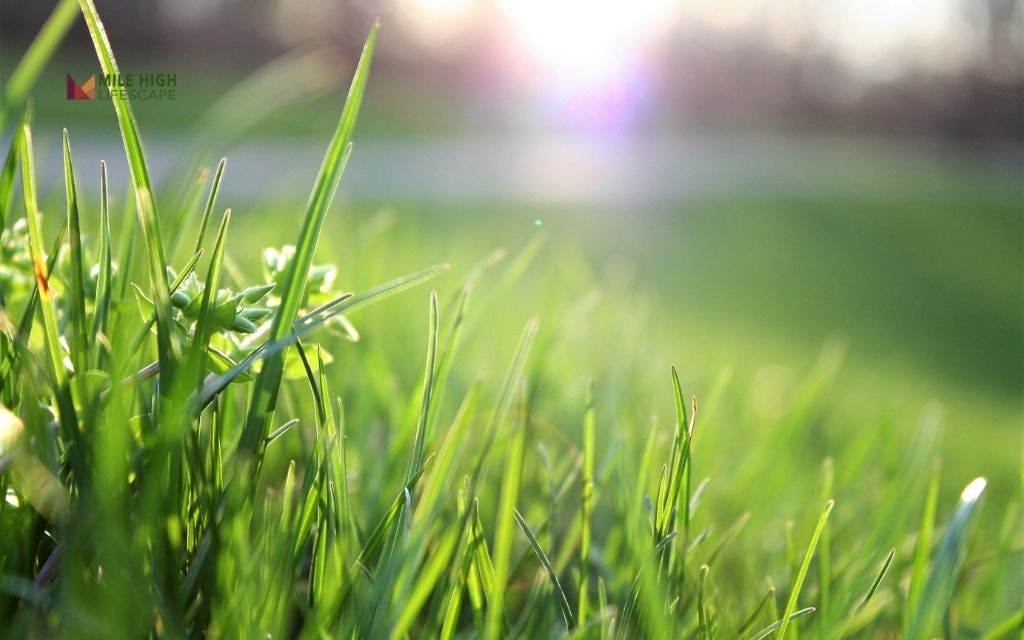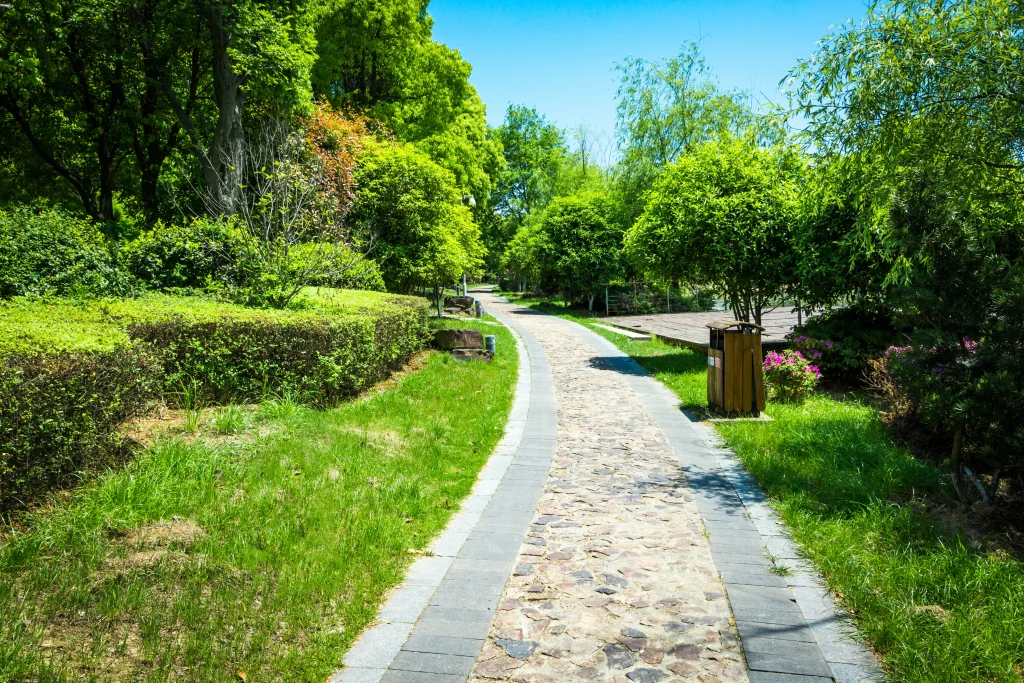The best time of day to mow lawn in hot weather is either early in the morning (6-9 AM) or early in the evening (4-6 PM) after temperatures have cooled but before dusk. Mowing during peak heat puts unnecessary stress on grass, leading to browning, moisture loss, and potential long-term damage.
This timing becomes especially critical in Denver’s unique climate, where high altitude intensifies sun exposure and creates rapid temperature fluctuations. Selecting the wrong time to cut your grass doesn’t just affect appearance – it can fundamentally impact lawn health, water requirements, and recovery capability.
Throughout this guide, we’ll examine optimal mowing windows, signs that indicate when to avoid mowing, and Denver-specific strategies to maintain healthy turf through summer heat.
Best Time of Day to Mow Lawn in Hot Weather
Ideal Mowing Window
Early Morning (6–9 AM)
Early morning represents the best time of day to mow lawn in hot weather because:
- Grass blades contain maximum moisture after overnight recovery
- Cooler temperatures reduce stress on both grass and mower
- Cut grass has full daylight hours to heal before nightfall
- Lower evaporation rates conserve water in the soil
- Dew typically evaporates by 7-8 AM, reducing clumping
Give morning dew about 30-60 minutes to evaporate before mowing to prevent clumping and mower clogging. The slight moisture remaining helps minimize dust and provides ideal cutting conditions.
Early Evening (4-6 PM)
Early evening (4-6 PM) is also a suitable time for mowing, with these advantages:
- Cooling temperatures reduce stress on the grass
- Dry grass conditions prevent clumping
- Reduced sunburn risk for both grass and the person mowing
However, it’s important to finish by 6 PM to allow sufficient drying time before nightfall, as cutting after 7 PM increases fungal disease risk since moisture remains on blades overnight.

Times to Avoid
Midday (10 AM – 4 PM)
- Direct sun exposure at Denver’s elevation creates intense UV radiation
- Peak temperatures cause rapid moisture evaporation from cut grass
- Fresh cuts become entry points for heat damage
- Mowing creates additional stress during already challenging conditions
- Greater physical strain on the person mowing
Late Evening (After 7 PM)
- Cut grass remains wet overnight
- Moisture on blades creates perfect conditions for fungal development
- Grass needs daylight to begin photosynthetic recovery after cutting
- Limited visibility may lead to uneven cutting patterns
| Time of Day | Pros | Cons |
| Early Morning (6-9 AM) | – Cooler temperatures – Maximum grass moisture – Full day for recovery – Lower evaporation rate | – Morning dew may cause clumping – Wet grass can stick to mower |
| Midday (10 AM-4 PM) | – Grass completely dry – Maximum visibility | – Heat stress on grass – Rapid moisture loss – Increased sunburn risk – Physical strain |
| Early Evening (4-6 PM) | – Cooling temperatures – Dry grass conditions – Reduced sunburn risk | – Still potentially warm – Limited recovery time before night |
| Late Evening (After 7 PM) | – Coolest temperatures – Reduced water evaporation | – Moisture encourages fungal growth – Poor visibility – Noise concerns for neighbors |
How Heat Affects Your Lawn (Especially in Denver)
At 5,280 feet elevation, the Mile High City receives approximately 30% more UV radiation than sea-level locations, intensifying heat impact on grass. The combination of strong sunshine, low humidity, and rapid temperature fluctuations creates distinctive stress patterns in local lawns.
Kentucky bluegrass and tall fescue – Denver’s most common turf varieties – both enter self-preservation mode when temperatures consistently exceed 85°F.
During this stress response, grass:
- Reduces blade growth to conserve energy
- Pulls moisture from blades into root systems
- Enters dormancy if heat persists, appearing brown
- Becomes more susceptible to damage from traffic and mowing
The effects intensify during Denver’s characteristic “heat waves,” when temperatures remain elevated for several consecutive days without overnight cooling. Cutting grass during these periods compounds stress and can trigger complete dormancy.
Signs It’s Too Hot to Mow
Watch for these indicators that cutting should be postponed:
- Temperature exceeds 85°F (check local weather stations, as Denver’s microclimates vary significantly)
- Grass blades fold inward along their center line (a drought stress response)
- Footprints remain visible on the lawn for more than a few seconds
- Soil feels dry below the surface layer (check by inserting a screwdriver 4-6 inches)
- Grass appears dull, grayish, or shows signs of wilting
- Your local water provider has implemented drought restrictions
- You feel physically uncomfortable after just a few minutes outdoors
Remember: If conditions feel oppressive to you, they’re equally stressful for your lawn. Mowing in extreme heat creates a combination of mechanical damage and environmental stress that lawns struggle to overcome.

Mowing Tips for Hot Weather in Denver
Follow these techniques to minimize heat stress when mowing:
Raise Your Mower Height
Set cutting height to 3-3.5 inches for Kentucky bluegrass and tall fescue. Taller grass:
- Develops deeper root systems with better drought resistance
- Creates natural shade that keeps soil cooler
- Reduces evaporation and water requirements
- Outcompetes many summer weeds
Maintain Sharp Blades
Dull mower blades tear grass rather than cutting cleanly, creating:
- Larger wound surfaces that leak moisture
- Entry points for disease pathogens
- Increased recovery requirements
- Brown, jagged tips that reduce photosynthesis
Sharpen blades at least three times during Denver’s growing season.
Return Clippings to the Lawn
Grass clippings provide multiple benefits during hot weather:
- Return moisture and nutrients to the soil
- Create a light mulch layer that reduces evaporation
- Provide up to 25% of nitrogen requirements
- Decompose quickly during summer heat
Use a mulching mower that chops clippings finely and distributes them evenly.
Adjust Mowing Frequency
During intense heat:
- Extend time between mowings to 7-10 days
- Monitor growth rather than following a strict schedule
- Follow the “one-third rule” – never remove more than one-third of the blade height in a single mowing
- Skip mowing entirely during drought-induced dormancy
Lawn Recovery Tips if You Mowed at the Wrong Time
If you’ve cut your grass during peak heat or notice signs of stress after mowing, implement these recovery strategies:
- Water deeply (1-1.5 inches) the morning after an evening mow
- Apply a quarter-inch of water immediately after a morning mow during extreme heat
- Avoid all foot traffic on stressed areas
- Suspend fertilization until temperatures moderate
- Consider applying a light application of kelp extract or seaweed-based biostimulant
- Allow grass to grow 25% taller than normal before the next mowing
Remember that Denver’s water restrictions often limit irrigation frequency. Focus available water on recovery periods after mowing rather than maintaining a rigid watering schedule.

When to Ask a Professional Lawn Care Provider for Help
Certain situations warrant professional intervention:
- Grass fails to recover within 5-7 days after stress symptoms appear
- Large patches turn completely brown despite adequate water
- Fungal disease symptoms emerge (circular patterns, powdery appearance, or thread-like growths)
- You’re unable to maintain consistent mowing schedules during critical growth periods
Mile High Lifescape creates customized mowing and care schedules based on Denver’s microclimate variations, your specific grass variety, and local water availability. Our climate-adapted approach considers seasonal changes, ensuring your lawn receives appropriate care as conditions evolve throughout summer.
Conclusion
Mowing during early morning hours (6-9 AM) provides the optimal balance between grass health, water conservation, and heat stress prevention for Denver lawns. This timing allows cut grass maximum daylight hours for recovery while minimizing moisture loss during the hottest part of the day.
Remember that summer lawn care requires flexibility – adjust your schedule based on actual conditions rather than calendar dates. By respecting the biological needs of your grass and adapting to Denver’s unique climate challenges, you’ll maintain healthier turf with less water and fewer recovery periods.
For Denver homeowners seeking expert guidance on weather-smart lawn care, Mile High Lifescape offers comprehensive assessment and maintenance programs tailored to local conditions. Contact us to create a customized approach that keeps your lawn thriving through summer heat while respecting water conservation goals.
Frequently Asked Questions (FAQs)
Is it better to cut grass in the morning or evening on a hot day?
Morning mowing (6-9 AM) offers better conditions than evening cutting in Denver. Morning allows the grass full daylight hours to recover before nightfall, while evening cutting leaves moisture on blades overnight, increasing fungal disease risk. If morning isn’t possible, aim for early evening (4-6 PM) when temperatures have begun to drop but at least 2-3 hours of daylight remain.
What temperature is too hot to cut grass?
The temperature is too hot to cut grass at 85°F and above. At this threshold, grass enters conservation mode and cutting creates additional stress that may trigger dormancy.
When not to cut grass in summer?
During a heat wave – a period of abnormally hot weather that lasts longer than 2 days – it’s recommended that you do not mow your lawn. Also avoid cutting during drought conditions when grass shows signs of stress (folded blades, footprints remaining visible, dull coloration).
What is the 1/3 rule in mowing?
The 1/3 rule in mowing states that you should never remove more than one-third of the total grass height in a single cutting. For example, if you maintain your lawn at 3 inches, mow when it reaches 4.5 inches tall. This prevents shock to the plant, reduces moisture loss, and maintains sufficient leaf surface for photosynthesis.
Is 7 PM too late to mow the lawn?
Yes, 7 PM is too late to mow the lawn in most situations. Lawns are most susceptible to fungal infection after dark, so avoid cutting your grass after 6 PM under any circumstances as that will weaken it further. Cut grass needs time to dry before nightfall, and the reduced visibility at this hour often results in uneven cutting patterns. Stick to a schedule and complete all mowing by 6 PM for optimal lawn health.
